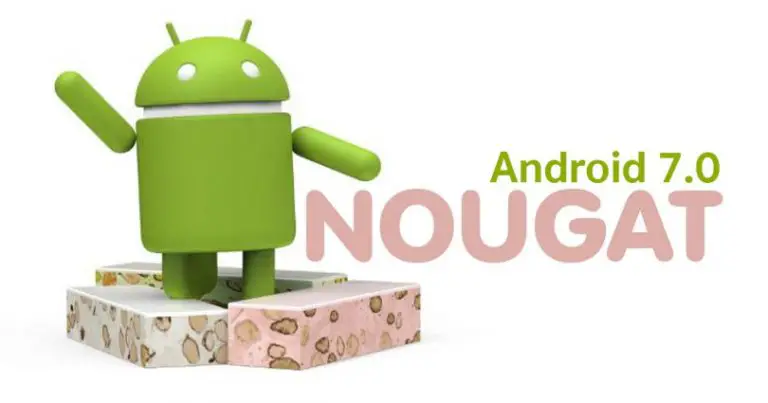Android 7.0 Nougat
Android 7.0 “Nougat” is the seventh main version of the Android operating system. It was first released as a beta build on 9th March, 2016, while it was officially released on 22nd August, 2016.
Nougat introduces noteworthy changes to the operating system and its development podium, which includes the ability to show multiple apps on-screen at once in a split-screen view, support for inline responses to notifications, as well as an OpenJDK-based Java environment and support for the Vulkan graphics rendering API, and “seamless” system updates on reinforced devices.
Android 7.0 Nougat” is a thing of beauty. It may not have the same dramatic visual service we had in Android Lollipop but Nougat provides a lot of major improvements and refinements over Marshmallow, along with quite a few good new usability changes.
Android 7.0 will be very familiar to anyone that has seen the latest Android N developer preview.
Anyone that has seen the Android N developer broadcasts will no doubt see many of similar Android Nougat features here.
Features of Android 7.0 Nougat
Following are the key features of Android Nougat
-
Multi-window Support
Consumers can now pop open two apps at a time on the screen. On tablets and phones having Android 7.0, consumers can run two apps side-by-side or one-above-the-other in split-screen mode. Users can resize the apps by dragging the divider between them.
-
Notifications
In Android 7.0, notifications are redesigned to make them feasible and faster to use. Some of those changes include:
- Template updates: Notification templates have been updated to put a new importance on hero image and avatar. Designers will be able to take benefit of the new templates with minimal modifications in their code.
- Messaging style customization: One can customize more of the user interface labels concomitant with his notifications utilizing the Messaging-Style class. Also, can organize the message, conversation title, and content sight.
- Bundled notifications: The scheme can do group messages together, for instance by message topic, and exhibit the group. A consumer can take numerous actions, like Dismiss or Archive, on them in place.
- Direct reply: For real-time message apps, the Android system supports inline responds so that consumer can quickly reply to an SMS or text message directly within the notification interface.
- Custom views: Two new APIs allow user to leverage system beautification, such as notification headers and actions, while using custom views in notifications.
-
Profile-guided JIT/AOT Compilation
Profile-guided compilation allows ART manage the AOT/JIT compilation for every app as per its actual usage, as well as circumstances on the device. For instance, ART organizes and maintains a profile of every app’s hot procedures and can pre-compile and cache those procedures for best performance. It doesn’t compile the other parts of the app until they are truly used.
Besides cultivating performance for key parts of the app, profile-guided compilation helps lessen an app’s complete RAM footprint, including linked binaries. This feature is specifically important on low-memory maneuvers.
ART approaches profile-guided compilation in a way that diminishes impact on the system’s battery. It also does pre-compilation but only when then the system is idle and charging, saving time and battery by doing that work in advance.
-
Quick Path to App Install
One of the most tangible aids of ART’s JIT compiler is the speed of app installs and device updates. Even huge apps that need several minutes to augment and install in Android 6.0, but one can now optimize and install such apps in just few seconds. System updates are also quicker, since there’s no more optimizing phase.
-
Doze on the Go
Android 6.0 had familiarized Doze. It is a system mode that saves battery by complying apps’ CPU and network activities when the device is not in working condition, like when it’s resting on a table or in a drawer.
Now in Android 7.0, Doze took a step forward; it saves battery while on the go. Any time the screen is turned off for a period of time and the device is unplugged, Doze smears a subset of the accustomed CPU and network restrictions to apps. This means consumers can save battery even when having their systems or devices in their pockets.
Also see : Android App Integration
-
Background Optimizations
Background handling is an important part of most apps. When optimized right, it can make user experience amazing — instant, quick, and context-aware. When not optimized right, background handling can unnecessarily consume RAM (and also battery) and disturb system performance for other apps. It thus strains memory and the battery.
-
Surface-View
Android 7.0 brings synchronous association to the Surface-View class, which offers better battery performance than Texture-View in some cases: When executing video or 3D content, apps with vigorous, scrolling and animated video location consume less power with Surface-View than with Texture-View.
-
Data Saver
Android 7.0 presents Data Saver mode, a new device service that helps in reducing cellular data being used by apps, whether wandering, near the end of the billing cycle, or on a tiny prepaid data pack. Data Saver provides users control above how apps utilize cellular data and lets developers deliver more efficient facility when Data Saver is on.
-
Vulkan API
Vulkan is deliberated to minimize CPU overhead in the driver, and let application to regulate GPU functions more directly. Vulkan also empowers better parallelization by letting multiple threads to achieve work such as command buffer construction at once.
Vulkan development apparatuses and libraries are trolled into the Android 7.0DK. They comprise:
- Headers
- Validation layers (debug libraries)
- SPIR-V shader compiler
- SPIR-V runtime shader compilation library
-
Quick Settings Tile API
Quick Settings is a famous and easiest way to expose key settings and actions, straight from the notification shade. Android 7.0 has expanded the scope of Quick Settings to make it even further useful and convenient.
More rooms have been added for extra Quick Settings tiles, which consumers can access across a paginated exhibition area by swiping left or right.
-
Number Blocking
Android 7.0 now ropes up number blocking in the podium and provides a outline API to allow service providers maintain a blocked-number list. The default SMS app, the carrier app, and default phone apps can read from and write to the blocked-number list. The list is not reachable to other apps.
-
Call Screening
Android 7.0 enables the default phone app to monitor incoming calls. The phone app ensures this by implementing the fresh Call-Screening-Service, which lets the phone app to execute a number of actions founded on an incoming call’s Call-Details, for example:
- Reject the incoming call
- Do not allow the call to the call log
- Do not show the user a notification for the call
-
Locales and Languages
Android 7.0 now allows users select various locales in Settings, to well support fluent use-cases. Apps can utilize a new API to gain the consumer’s selected locales and then propose more sophisticated user practices for multi-locale users — like displaying search results in numerous languages and not allowing translating web-pages in a language the consumer already knows.
Android 7.0 also enlarges the range of languages accessible to users along with multi-locale support. It offers more than 25 alternatives each for often used languages such as English, Spanish, French, and Arabic. It also augments partial support for more than 100 different and new languages.
-
New Emojis
Android 7.0 familiarizes additional Emojis and Emoji-related features which include a skin tone Emojis and support for variation selectors.
-
ICU4J APIs in Android
Android 7.0 now compromises a subset of ICU4J APIs in the Android agenda under the android.icu package. Relocation is easy, and typically entails simply altering from the com.java.icu name-space to android.icu.
-
Android TV Recording
Android 7.0 complements the capability to record and playback content from Android TV input facilities via new recording APIs. Building on topmost of existing time-shifting APIs, TV input services can regulate what channel data can be documented, how these documented or recorded sessions are kept, and manage user collaboration with recorded content.
-
Android for Work
Android for Work offers numerous new features and APIs for systems running Android 7.0. Some of them are below
- Work profile security challenge
- Turn off work
- Always on VPN
- Customized provisioning
-
Accessibility
Android 7.0 now adds Vision Settings directly on the Welcome display for new device setup. This makes it quite easier for users to explore and configure accessibility topographies on their devices, which include magnification gesture, display size, font size, and also Talk-Back. One can make them enable from Settings > Accessibility.
Also Read : Android New Record
-
Direct Boot
Direct boot improves device startup times and lets registered apps have limited functionality even after an unexpected reboot. For example, if an encrypted device reboots while the user is sleeping, registered alarms, messages and incoming calls can now continue to notify the user as normal. This also means accessibility services can also be available immediately after a restart.
-
Key Attestation
Android 7.0 present’s key attestation, a new safety tool that helps you be sure that the key pairs warehoused within a system’s hardware-backed key-store appropriately protect the sensitive material that your app utilizes.
-
Keyboard Shortcuts Helper
In Android 7.0, the consumer can press Meta + / to trigger a Keyboard Shortcuts screen that shows all shortcuts available both from the device and from the app in center. The system recovers these shortcuts robotically from the app’s menu if the shortcuts are present.
-
Custom Pointer API
Android 7.0 familiarizes the Custom Pointer API, which allows you customize the look, visibility, and actions of the pointer. This proficiency is especially beneficial when a user is utilizing a mouse or touch pad to intermingle with UI objects. The default pointer utilizes a standard icon.
-
Sustained Performance API
Performance can sway dramatically for long-running apps, since the device controls system-on-chip engines as system components touch their temperature limits. This fluctuation gives a moving target for app designers creating high-performance, long-running apps.
To report these limitations, Android 7.0 comprises support for constant performance mode, that enables OEMs to provide hints regarding device-performance competences for long-running apps. App developers can practice these hints to tune up apps for a predictable, steady level of system’s performance over extensive periods of time.
Don’t miss : Android Turns Your Phone Into Harry Potter’s Magic Stick





Prednisone
can I Take Cialis Just When Needed?
order modafinil 100mg without prescription oral modafinil 200mg modafinil order online
Your point of view caught my eye and was very interesting. Thanks. I have a question for you.